Mine and Mine Only: The Marriage Proposal and Engagement
by Ann Haddad
This is the second in a series of blog posts on mid-19th century courtship and wedding customs. Click here to read the first post, on 19th century courtship.
A Horse and a Wife
Charles A. Bristed, in his satirical sketch of American society, The Upper Ten Thousand (1852), noted:
“The first thing, as a general rule, that a young Gothamite does is to get a horse; the second, to get a wife.”
Although it is uncertain if Effingham Nichols owned a horse, he did indeed acquire a wife, the bride being none other than Elizabeth Tredwell, eldest daughter of Seabury and Eliza Tredwell. Effingham was only two years into his law practice, located on 7 Nassau Street, when he wed the very eligible 23-year-old Elizabeth on April 9, 1845. We do not know the duration of their courtship, but Effingham must have received significant encouragement from the young lady during that time, emboldening him to declare his love and to propose marriage.
Never Flirt!
Asking a young woman for her hand in marriage was never perceived as an easy task for a gentleman. After all, his fate rested in her hands! For this reason, the etiquette manuals of the day warned women repeatedly not to trifle with a young man’s affections, lest it earn the woman the dreaded reputation of being a flirt. If a gentleman’s behavior towards a woman conveyed romantic feelings, and she did not wish to encourage him, she was to do her utmost to gently rebuff his sentiments in a kindly manner, and gradually withdraw from his company. An honorable woman never shared (except with her parents) that she had rejected a suitor. As A Manual of Etiquette (1868) stated:
“If you possess either a decent generosity, or the least good breeding, you will not divulge a secret which should be sacred between you.”
Passing the Test
| … |
After their courtship had gone on for an appropriate period (etiquette manuals were reluctant to establish the proper length of the courtship period), a woman who found the attention from her suitor more than agreeable indicated in unspoken ways that a proposal of marriage would be welcome. She, of course, could not propose to a gentleman (only queens were permitted to do so; Queen Victoria notably proposed to Prince Albert); but, according to the Dictionary of Love (1858):
“… she may lawfully do all in her power to put him in the notion of proposing. She may be very glad to see him when he calls, she may gently chide him for staying away so long ‘We feared you had forgotten us,’ or she may, by the purest accident, always happen to get a seat very near him whenever she is in his company. It is clearly a lady’s right to modestly open the way for the approaches of a gentleman whose heart she honorably wishes to obtain.”
A young lady’s father (especially a wealthy one like Seabury Tredwell, who needed to protect his daughter from fortune hunters) had already assessed the suitor’s finances (were his prospects good enough to provide a home for and support a wife and children?), scrutinized his lineage (did he come from a reputable family?), and deemed him acceptable. At this point, it was safe and indeed incumbent on the young man to seize the opportunity and proceed with a proposal. As stated in The Art of Good Behavior (1846), a popular etiquette manual:
“As a general rule, a gentleman need never be refused. Every woman, except a heartless coquette, finds the means of discouraging a man whom she does not intend to have, before the matter comes to the point of a declaration.”
An unidentified young clerk in New York City indicated his confidence that he had a future with his beloved Julia when he wrote in his diary on October 13, 1844:
“Was much amused at a remark Julia made. She said ‘I don’t know how to take you.’ I replied ‘Take me as I am.’ She answered, ‘I expect I shall be obliged to.’ It may be a prophetic remark.”
Once the suitor determined that his offer of marriage would be welcomed, there was nothing left to do but “pop the question” (an idiom in use since 1826). The Art of Good Behavior perfectly captured the anxiety of the moment:
“… and though he may tremble, and feel his pulses throbbing and tingling through every limb; though his heart is filling up in his throat, and his tongue cleaves to the roof of his mouth, yet the awful question must be asked.”
Will You Marry Me?
Should a gentleman find elusive the right words with which to propose, he needed only consult one of the popular etiquette manuals, which offered many suggestions. Here are some from The Art of Good Behavior:
“Will you tell me what I most wish to know!”
“Yes, if I can.”
“The happy day when we shall be married?”
“Have you any objection to change your name?” “How would mine suit you?”
“One word from you would make me the happiest man in the universe.”
“Well, Mary, when is the happy day?” “What day, pray?” “Why, everybody knows we are going to get married, and it might as well be one time or another; so, when shall it be?”
And then there was the laconic gentleman who, according to the Evening Post of August 14, 1840, proposed in the following manner:
“Pray, madam, do you like buttered toast?” “Yes, sir.” “Buttered on both sides?” “Yes, sir.” “Will you marry me?”
The joyous declaration of love was described in the Etiquette of Courtship and Matrimony (1852):
“The happy moment of opportunity arrives, in sweet suddenness, when the flood gates of feeling are loosened, and the full tide of mutual affection gushes forth uncontrolled.”
James R. Burtin, a young New York gentleman who worked as an engraver, recorded in his diary the exciting moment when, after nearly two years of courtship, he proposed to his beloved Ann Elisa on February 18, 1844:
“This is an evening I shall always remember with mingled feelings of pleasure and pain. One question I asked my dear Ann, the answer of which depended my future happiness or misery and she hesitated to answer it. It was a moment of suspense tho if she knew how I loved her and how dear she is to me she would have given me an answer at once. I did not doubt but that her answer would be such as one as I wish and the answer was one that put all doubt aside. She loves truly and I love her and whatever may take place I shall love her as long as life shall last. She is dearer to me than Mother, brother or Sister. Without her I may almost say that life would be unendurable, but now all doubts are at an end. She is mine and mine only.”
Put It in Writing
For those timid, tongue-tied gentlemen who could not bear the thought of proposing in person, etiquette manuals, such as the American Fashionable Letter Writer (1845), also offered sample proposal letters, such as:
“Every one of those qualities in you which claim my admiration, increased my diffidence, by showing the great risk I run in venturing, perhaps before my affectionate assiduities have made the desired impression upon your mind, to make a declaration of the ardent passion I have long since felt for you.”
On October 28, 1843, Henry Patterson, a contemporary of Burtin’s, wrote in his diary about his written proposal of marriage to Eleanor Wright:
“Last week Thursday I made proposals of marriage to her in writing; Sunday evening I received a conditional acceptance, also in writing, and Wednesday evening we spent in unfolding to each other our situation, prospects, hopes, principles, feelings, in short everything which would tend to a judicious and proper settlement of the question now the subject of our joint consideration. I will only record, that as I become acquainted with her, I become more thoroughly convinced of our suitableness to each other; and the outpouring of tender feelings which I enjoyed on Wednesday evening, that sensation of mutual love and trust which I have since felt within us, renders the present the happiest period of my life.”
| … |
I’ll Get Back to You
When a gentleman made an offer of marriage either in person or by letter, it was incumbent upon the young lady to receive it graciously. She knew, either by instruction from her parents or by the advice provided by etiquette manuals, never to accept or reject the offer immediately. Such an important decision merited deep reflection, and discussion with her parents, whose consent was necessary before any answer was given. As Farrar reminds her readers in The Young Lady’s Friend (1837):
“It should be an avowed principle of your life, that you will never marry without the consent of your parents, nor merely to please them.”
If the young lady’s parents opposed the match, the couple carefully considered the objection, and perhaps delayed their marriage until the reason for the disapproval had been overcome.
The American Fashionable Letter Writer provided an example of a young lady’s written reply to a proposal of marriage:
“There are many points beside mere personal regard to be considered; these I must refer to the superior knowledge of my father and brother, and if the result of their inquiries is such as my presentiments suggest, I have no doubt my happiness will be attended to by a permission to decide for myself.”
Man to Man
After proposing marriage, the next daunting step for the gentleman was a formal meeting with the woman’s father, to officially ask for his consent to the marriage. It is noteworthy, with regard to parental consent, that the opinion of the young woman’s parents appears to be the only one that matters. None of the diaries consulted for this post made any mention of the suitor’s parents in any aspect of the courtship or engagement. As Ellen K. Rothman concluded in Hands and Hearts: A History of Courtship in America (1984), “A woman’s parents were asked; a man’s parents were told.”
Seabury Tredwell was probably not surprised when Effingham Nichols entered his study to request Elizabeth’s hand in marriage; he most likely was expecting it. Effingham would have been prepared to discuss his law practice, his future prospects, and his financial situation in detail. He was, after all, responsible for providing a stable economic environment for Seabury’s daughter; it was critical that he explain how he planned to go about this. Seabury already knew Effingham came from an excellent family, and must have been willing to accept Effingham’s status and envision his future success. Imagine the joyful scene on Fourth Street when, once Seabury gave the couple his blessing, Elizabeth and Effingham shared the happy news with her mother, Eliza, and her siblings!
The parents of Eleanor Wright, the young woman with whom Henry Patterson was in love, were separated (separation and divorce were not as uncommon as we might think — a topic for a future blog post). That may explain why it took two months for Henry to meet with her father. On December 30, 1843, he wrote:
“By mutual agreement that it was advisable, I called the next morning on her Father, in Fifth Street, and briefly acquainted him with my past intercourse with his daughter and my plans for the future; I asked his approval. He expressed his approbation as far as he was acquainted with the circumstances, and treated me in every respect in a gentlemanly manner.”
We have no idea what Elizabeth’s siblings thought of her suitor, Effingham Nichols. The opinion of brothers and sisters held little weight when it came to choosing a mate for life. Elizabeth Brevoort was a young girl of fourteen when on July 31, 1848, she wrote in her diary of her sister’s love interest:
“I must say it is not the marriage I wish for her but if she thinks she will be happy with him, I am sure it is none of my business.”
The Engagement Period
Patrick W. O’Neil, in his dissertation thesis, Tying the Knots: The Nationalization of Wedding Rituals in Antebellum America (2009), described the engagement period (which typically lasted from six months to two years, depending on the family circumstances and the age of the couple) as a moment of transition between courtship and married life wherein couples could come to a full understanding of the meaning behind their commitment to one another. It was viewed as an opportunity for the lovers to imagine themselves married, and to declare their suitability to the world. In doing so, they experienced a loosening to some extent of the restrictive bonds of decorum, and hence were able to deepen their knowledge of each other. O’Neil cautioned, however, that the easing of rules in this rigid society only went so far:
“None of this is to say that the middle-class men pursued gender equality in their married relationships: they would not have taken kindly to assertions of autonomy from their future wives.”
In the mid-19th century, once the young lady and her parents consented to the marriage, the announcement of the engagement was initially made to family and intimate friends only; this was typically done in writing. This allowed all involved to take a collective breath and live with the idea; it would be during this time that either party could gracefully break off the engagement without doing widespread damage. After a week or two, the wider circle of friends and acquaintances would receive news of the engagement.
The Ring-Bearers
According to Ellen Rothman, in Hands and Hearts, the custom of presenting one’s betrothed with a ring upon engagement began in the 1840s. The simple bands, which sometimes included a cut stone, were mutually exchanged; they served as a public sign of the couple’s commitment to each other. Occasionally, another personal token, such as a portrait miniature of the future bride, was presented to the groom-to-be in place of a ring. Diamond engagement rings as we know them today did not become popular until Tiffany & Co. introduced the Tiffany setting in 1886.
Behave Yourselves
Not surprisingly, the conduct of a betrothed couple was also governed by a strict protocol. When in public, any overt signs of familiarity and exclusivity were forbidden. The gentleman was to behave gallantly and honorably toward any woman in his presence, not just to his fiancée; and his future bride refrain from pouting or reacting with jealousy and anger when he did so. That didn’t mean, however, that the gentleman refrained from being protective of his sweetheart, or that she ignored him. Ideally, they presented to the world an image of blissful and contented happiness. Although the couple did not isolate themselves from the society of others, the woman was careful to avoid spending time with any other man in private. When attending sociables and other entertainments in the absence of her betrothed, etiquette dictated that she be accompanied by a family member or intimate family friend.
In private, a gentleman never took advantage of his bride-to-be, for he had her honor to maintain. As the Etiquette of Courtship and Matrimony (1852) pointed out: “he is dealing with his future wife.” Whenever he was in the presence of his betrothed, it was a young man’s duty to avoid any display of fatigue, low spirits, or “excessive animation.” Several etiquette manuals also discussed the engagement period as a time when a gentleman bore the responsibility of advising and guiding his betrothed, by correcting her faults and helping to mold her character. It was the rare mid-19th century treatise, such as Mrs. A.J. Graves’ Woman in America (1858) that challenged this notion, stating, “woman was not given to a man for a toy to amuse his idle hours; but to be, in truth and in reality, a helpmate to him – a minister for good.”
The Welcome Mat
Once the engagement was underway, the gentleman was expected to pay frequent calls at his bride-to-be’s home. He was to ascertain, however, the time most convenient for his call; and when he visited, he was to focus attention on the entire family, not just on his betrothed. His aim in making the calls was to gradually win the affection of the family, especially the girl’s mother. The visits were usually made in the evening, with the gentleman wearing evening attire, as he would for the theatre or a concert. As the Etiquette of Courtship and Matrimony stated,
“The neglect of this point would betray, first, a carelessness in habits, next, a want of deference to the lady’s family, and lastly, a deficiency in due respect to herself.”
According to their diary entries, both Henry Patterson and James Burtin could be found almost nightly at the homes of their betrothed. Often they had tea with the family in the afternoon and then return in the evening! Burtin, who had made a habit of frequent visits even before his engagement, wrote in his diary on November 16, 1843:
“I am inclined to think that love makes a fool of a man , that is in other people’s estimation, but what is the use. I love Ann Elisa and when I can see her there is not the least doubt but that I will.”
| .. |
Stealing a Kiss
Despite the protocol set forth in popular etiquette manuals, evidence in diaries of this period indicates that betrothed couples were frequently left alone in the young lady’s home, often until 1 or 2 a.m. Henry Patterson and Eleanor Wright spent many evenings alone in her parlor, playing chess, whist, reading to one another, and ultimately exchanging mutual affection. On January 21, 1844, he wrote:
“Monday evening I spent with Eleanor, with chess, reading, and conversation, all of which, having mingled with them expressions of the most tender love and kindest feelings, served to render that evening one of the happiest seasons of my life.”
James Burtin even exercised with Ann Elisa, as he wrote on his diary on May 25, 1843:
“In the evening called over to see Ann Elisa found her jumping the rope joined in with her and had some fine exercise but found it rather warm work.
“This is a Waste of Our Time”
Once betrothed, couples were permitted to go out together unaccompanied: for walks on the Battery; to concerts at Niblo’s Garden; to museums, theatre, church, lectures, and to weddings of friends and family. After months of such activity, with no wedding date yet set, Henry Patterson was growing increasingly frustrated. He wrote in his diary on March 24, 1844:
“Oh! how tired and impatient I feel, to be thus compelled to take a part in amusements, and join in company for which I feel no affinity. Enjoying alone Eleanor’s society, with no restraints on the interchange of tokens of love, is almost the only thing that is at all satisfactory to me: how painful to me that this is a waste of our time, in foolery, and empty amusements. Yet, may it not be played upon us to exercise our patience, and and learn us to prize more highly and justly the unspeakable blessing which we do enjoy?”
Fixing the Day
The days of idle amusements were soon over for Henry and Eleanor; once their marriage date was set (by the woman, this being one of her express privileges), they found themselves busier than ever. There was a household to set up, a trousseau to purchase, and a wedding to arrange. As the wedding industry was in its infancy, it was typical for a wedding date to be announced only two to three weeks prior to the actual date. As a result, the wedding preparations were intense and extensive, requiring hard work by both parties. The burden, as we shall see, rested more on the woman’s shoulders, for as Rothman points out in Hands and Hearts: “While engagement interfered with a man’s work, it was a woman’s work.”
Sources:
- Anonymous. The American Fashionable Letter Writer, Original and Selected. Troy, N.Y.: W. & H. Merriam, 1845. www.catalog.hathitrust.org. Accessed 3/1/18.
- Anonymous. The Art of Good Behavior, and Letter Writer, on Love, Courtship, and Marriage: A Complete Guide. New York: Huestis & Cozans, 1845. Main Collection, New-York Historical Society.
- Anonymous. The Etiquette of Courtship and Matrimony: With A Complete Guide to the Forms of a Wedding. London: David Bogue, 1852. www.books.google.com. Accessed 2/2/18.
- Arthur, T[imothy]S[hay]. Advice to Young Ladies on Their Duties and Conduct in Life. Boston: Phillips, Sampson, 1847. babel.hathitrust.org. Accessed 1/16/18.
- Brevoort, Elizabeth. Diary, 1848. Rare Books and Manuscripts Division, New York Public Library.
- Bristed, Charles Astor. The Upper Ten Thousand; Sketches of American Society. London: Parker and son, 1852. www.babel.hathitrust.org. Accessed 2/13/18.
- Diary of an Unidentified Clerk in New York City, 1844-45. MssCol. 2147, Rare Books and and Manuscripts Division, New York Public Library.
- Diary of an Unidentified Young Man [James R. Burtin], January 1, 1843- 1844. Manuscripts Division, New-York Historical Society.
- Farrar, Mrs. John. A Young Lady’s Friend. Boston: American Stationers’ Company, 1838. www.archive.org. Accessed 1/23/18.
- Graves, Mrs. A.J. Woman in America; Being an Examination into the Moral and Intellectual Condition of American Female Society. New York: Harper and Brothers, 1858. www.catalog.hathitrust.org. Accessed 3/2/18.
- Johnson, S. O. [Sophia Orne]. A Manual of Etiquette with Hints on Politeness and Good Breeding. Philadelphia: D. McKay, 1868. www.archive.org. Accessed 2/26/18.
- O’Neil, Patrick W. Tying the Knots: The Nationalization of Wedding Rituals in Antebellum America. Dissertation Thesis, University of North Carolina, Chapel Hill, 2009. www.cdr.lib.unc.edu. Accessed 3/1/18.
- Patterson, Henry. Diaries, 1832-1848. Manuscripts Division, New-York Historical Society.
- “Popping the Question.” The Evening Post, Fri., August 14, 1840, p. 2. www.newspapaers.com. Accessed 2/28/18.
- Rothman, Ellen K. Hands and Hearts: A History of Courtship in America. New York: Basic Books, Inc., 1984.
- Theocritus, Junior [pseud.]. Dictionary of Love. New York: Dick & Fitzgerald, 1858. www.archive.org. Accessed 2/5/18.
- “Tiffany and Co. History,” Tiffany & Co. www.press.tiffany.com. Accessed 3/2/18.
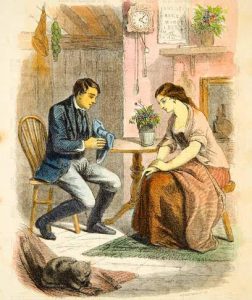
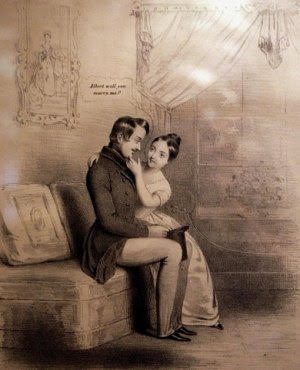
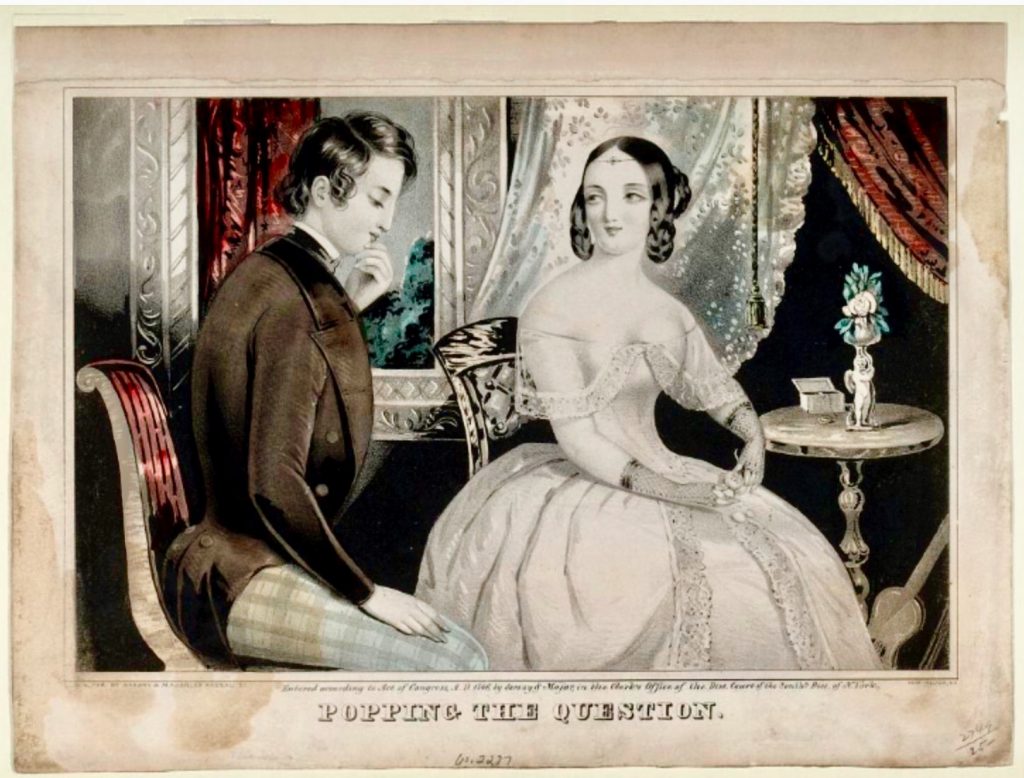

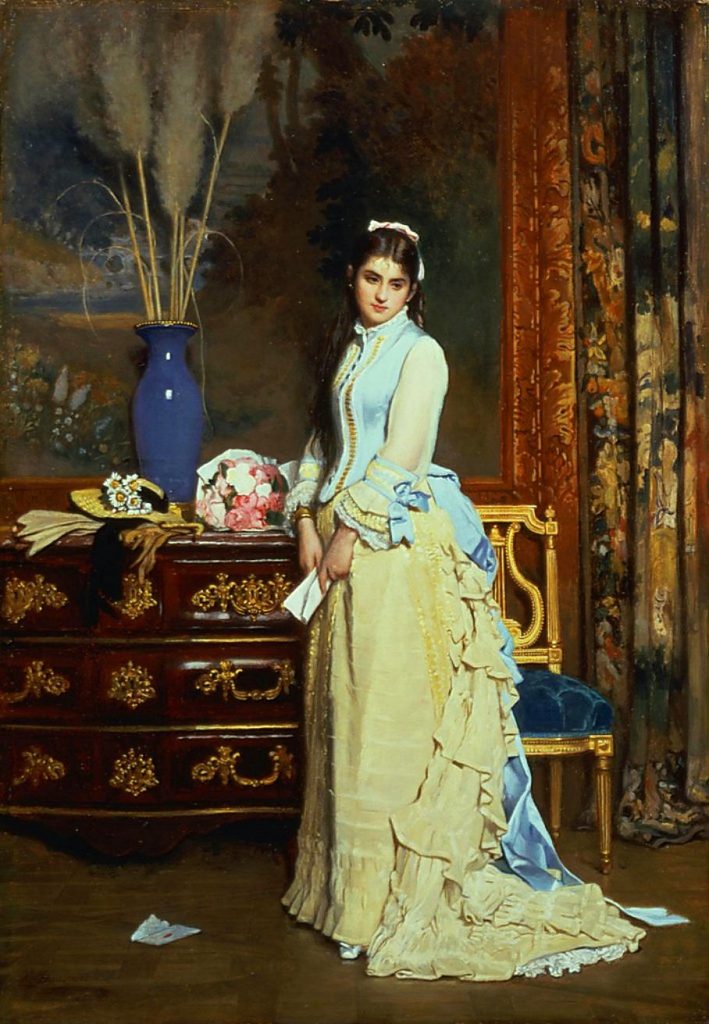
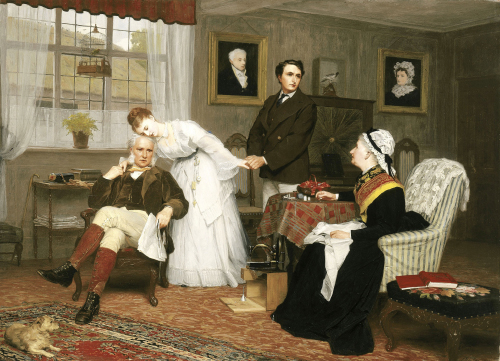
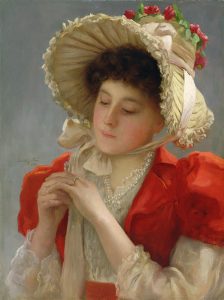
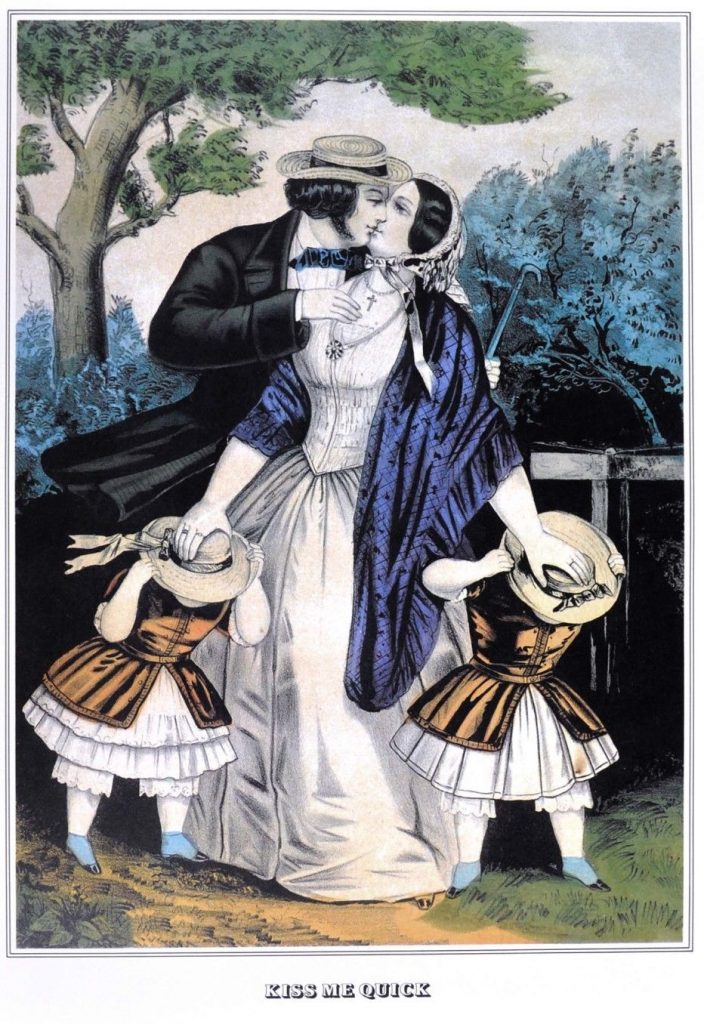



Hard to think of any aspect of social behavior that has undergone more of a change during since Victorian times than the relation between the sexes and the decision (or not) to marry. Fascinating stuff, Annie!
Thank you, Mary! The changes were especially notable after the mid century, for so many reasons. There is so much more to explore!
Excuse the typo, please!
Check out the expression on the woman’s face in the Sarony & Majors print:
“I know what you’re thinking!”
[…] on mid-19th century courtship and wedding customs. Click for Part One, on 19th century courtship; Part Two, on marriage proposals and engagements; and Part Three, on wedding […]
Well-written, well-researched and just a delight to read. Thanks.
Thank you!